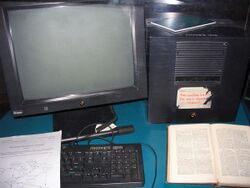Software:CERN httpd
| Original author(s) | Tim Berners-Lee, Ari Luotonen, Henrik Frystyk Nielsen |
|---|---|
| Developer(s) | CERN / World Wide Web Consortium |
| Initial release | 24 December 1990 |
| Final release | 3.0A
/ 15 July 1996[1] |
| Operating system | Unix, Unix-like |
| Available in | C |
| Type | Web server, proxy server |
| License | MIT Copyright Statement with acknowledgement to CERN |
| Website | www |
CERN httpd (later also known as W3C httpd) is an early, now discontinued, web server (HTTP) daemon originally developed at CERN from 1990 onwards by Tim Berners-Lee, Ari Luotonen[2] and Henrik Frystyk Nielsen.[1] Implemented in C, it was the first web server software.
History
CERN httpd was originally developed on a NeXT Computer running NeXTSTEP, and was later ported to other Unix-like operating systems, OpenVMS and systems with unix emulation layers, e.g. OS/2 with emx+gcc. It could also be configured as a web proxy server.[1] Version 0.1 was released in June 1991.[3] In August 1991, Berners-Lee announced in the Usenet newsgroup alt.hypertext the availability of the source code of the server daemon (named WWWDaemon) and other World Wide Web software from the CERN FTP site.[4][5]
The server was presented on the Hypertext 91 conference in San Antonio and was part of the CERN Program Library (CERNLIB).[4][7]
Later versions of the server are based on the libwww library.[2] The development of CERN httpd was later taken over by World Wide Web Consortium (W3C), with the last release being version 3.0A of 15 July 1996.[1] From 1996 onwards, W3C focused on the development of the Java-based Jigsaw server.[8]
The initial version was public domain software; the last one was under an MIT License.[9]
See also
- Comparison of web server software
- Traffic Server
- Web accelerator, which discusses host-based HTTP acceleration
- Proxy server, which discusses client-side proxies
- Reverse proxy, which discusses origin-side proxies
References
- ↑ 1.0 1.1 1.2 1.3 Official CERN httpd page
- ↑ 2.0 2.1 Kahan, José (5 August 1999). "Why Libwww?". World Wide Web Consortium. http://www.w3.org/Library/Activity.html.
- ↑ Change History for httpd
- ↑ 4.0 4.1 Stewart, Bill. "Tim Berners-Lee, Robert Cailliau, and the World Wide Web – Web development". Living Internet. http://www.livinginternet.com/w/wi_lee.htm#dev.
- ↑ Tim Berners Lee (1991-08-20). "WorldWideWeb wide-area hypertext app available" (in en). CERN. https://groups.google.com/g/comp.sys.next.announce/c/avWAjISncfw?pli=1.
- ↑ "W3C Open Source Software – CERN Server". World Wide Web Consortium. http://www.w3.org/Status#CERN.
- ↑ Robert Cailliau (21 July 2010). "A Short History of the Web". NetValley. http://www.netvalley.com/archives/mirrors/robert_cailliau_speech.htm.
- ↑ Baird-Smith, Anselm (April 1996). "W3C Activity: The CERN server". World Wide Web Consortium. http://www.w3.org/Daemon/Activity.html.
- ↑ The birth of the web Licensing the web on cern.ch (2014, archived)
External links
- The historic W3C page for httpd
- The historic web site in the W3C archive of November 1992
- CERN republished her first website.
 |


